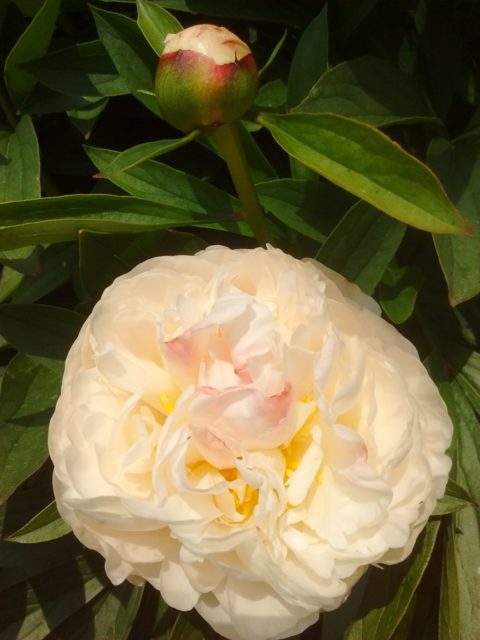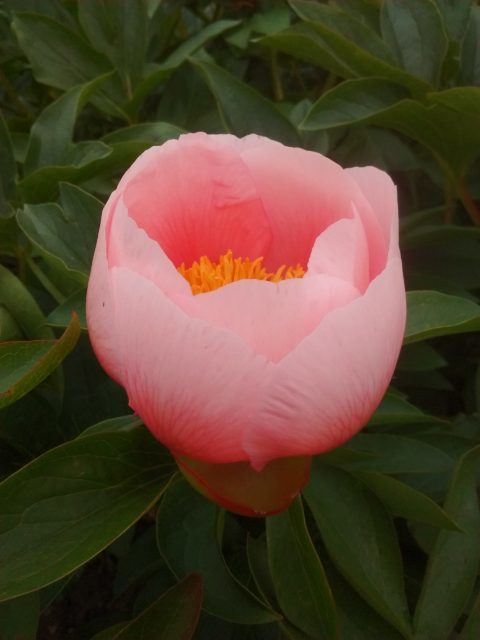Our yearly results of testing Ultra Low Oxygen (ULO) storage of peonies. After three years of failures and learning the hard way one would expect some success in year 4, no? Alas, long story short, it was mostly throwing money down the drain…
From past experience it was clear that we needed to get the relative humidity (RH) in the ULO boxes lower so that no condensation would occur and botrytis would be kept at bay. The silicagel in previous years was unable to keep RH at reasonable levels fast enough, so we changed tactics and went for calcium chloride. This substance can take much more moisture out of the air, works faster, can absorb more and also works fine at low temperatures. The only thing we were afraid of in fact is that the air would be too dry. You can read more about calcium chloride on the website of the producer, Absortech. The product we used was AbsorGel Hanging, which is a product that contains 1 kg of calcium chloride, divided over 8 bags in one long row, -together with some starch so that you get a rather gelly substance when it absorbs water- and the packaging material is tyvek paper which can withstand water and cannot be torn.
As usual a short description about the season as this differs from year to year. Quite average this year, with peonies flowering at the normal time, from mid-may to the end of that month for the most part. It was also dry during the season with hardly any rain. Given that it was continuously dry we didn’t spray with fungicides against botrytis. This is against the advice for long term storage of course, but in the long run most fungicides will be phased out anyway, the future is bound to be ‘greener’ and probably more ‘organic’.
The peonies were cut at the last days of May for the boxes, placed in the boxes (no prior water soaking) and left to dry for about a week in a cold storage. The calcium chloride sets were laid horizontally on top and the boxes were closed June 6th with all caps closed to decrease the oxygen levels fast. It took about a week for oxygen levels to go below 10%. Below are part of the measurements of oxygen (O2) and carbon dioxide (CO2). Given all the failures and the peony stems thrown away in previous years, we only used 4 boxes this time and filled them with the smaller ones. Box 2 was only half filled due to lack of enough stems. The Fawn was used again, but some stems of other cultivars were also added to compare. As were some bunches that had soaked up water. Temperature of the cold room was set at 0,3°C until Aug 2nd when it was raised to 1,8C. Aug 25th it was lowered again to 0,3°C. Some caps were opened when O2 levels went below 5% to raise it again. When this happened CO2 levels concurrently went down rather fast. Box 4 had one cap opened June 24th, closed again July 2nd. August 2nd, both box 3 and 4 had two caps opened.
| ULO 2022 | Box 1 | Box 2 | Box 3 | Box 4 | ||||
| Date | O2 % | CO2 % | O2 % | CO2 % | O2 % | CO2 % | O2 % | CO2 % |
| June 8th | 16,9 | 5,8 | 18,5 | 4,3 | 17,0 | 5,6 | 16,7 | 5,9 |
| June 13th | 11,23 | 11,0 | 14,16 | 8,5 | 10,63 | 11,5 | 9,7 | 12,3 |
| June 21st | 8,15 | 13,9 | 11,42 | 11,1 | 7,52 | 14,5 | 5,88 | 15,4 |
| July 2nd | 6,78 | 15,1 | 10,0 | 12,4 | 6,27 | 16,2 | 6,41 | 11,1 |
| July 15th | 7,17 | 15,1 | 10,11 | 12,3 | 6,64 | 16,1 | 5,59 | 13,9 |
| July 29th | 7,95 | 14,4 | 10,63 | 11,9 | 7,17 | 15,9 | 6,03 | 14,7 |
| Aug 2nd | 8,19 | 14,2 | 7,25 | 15,8 | 6,17 | 14,8 | ||
| Aug 16th | 8,90 | 7,9 | 7,24 | 7,6 | ||||
| Aug 23rd | 7,41 | 8,6 | 6,00 | 8,3 | ||||
| Sep 16th | na | na | ||||||
| Starting date June 6th. Opening dates in yellow. Temperature and Relative Humidity was logged in box 3 & 4. Box 2 only half full and only 1 set of calcium chloride. Other boxes 600-700 stems and 2 sets of calcium chloride. na = not available (no measurement done) | ||||||||
What did we seen when opening the boxes?
July 29 the first one, box 2, was opened, the one which was only half full and which never went below 10% Oxygen due to this. All stems came out fully dry, no condensation at all against the inside walls or cover. So one set of calcium chloride seemed to be sufficient in this case. As it weighed approximately 1 kg at the onset of the treatment and ended up weighing some 2,3 kg at the end, we can assume that about 1,3 kg (or litre) of water was taken out of the air. From about 380 stems, only about 15 showed some damage due to ‘grey flecks’ as in 2021. Those were the few ones with the buds in the middle of the box, hidden below the foliage of the stems above. The other ones were all placed with the buds towards the sides and these were fine. This made us think that those few bad ones may have had too few oxygen perhaps? The ones that had soaked up water were also fine, contrary to our results of 2019, but there was an issue however. All peonies in the box had dried out leaflets when opening the box. The ones that went in ‘dry’ however could be rehydrated and the leaflets became fine again, whilst the stems that had soaked up water couldn’t as the leaflets remained floppy and dry there. There was 0% botrytis on the stems, leaflets and flowers in this box. So we might call this a success, with the conclusions that no buds should be stored between the leaflets, only at the sides, and they shouldn’t soak up any water before placing in the boxes. They opened fine in a vase when tested.

After long term storage and rehydrating. Left the stems that had soaked up water before being placed in the box, on the right the ‘dry’ ones that went straight in after cutting
A few days later, August 2nd, we opened box 1, which had more stems in it (550) and two sets of calcium chloride. We were obviously hopeful after the success of the first box. However… Whilst there was no condensation here either and no botrytis to speak of (except for a fews stems that probably were infected during harvest already), half of the buds had grey flecks again, as they did last year. Last year we assumed it was due to the oxygen level going too low at some point, but this year it hadn’t gone so low, so we are unsure as to the reason. This meant a lot of work sorting them out unfortunately. Some of the added other varieties seemed to cope better than The Fawn: Rozella and Miss America had more good ones in comparison (some 10 stems each were tested for these varieties). Myrtle Gentry was bad. Bowl of Cream didn’t show those flecks, but most of the outer petals had dried up and were ugly. Old Faithful was fine, but only the ones that went into the box ‘dry’, not the ones that had soaked up water beforehand. Another conclusion: whilst the oldest one in the boxes had dried about a week before closing the cover, the freshest ones had only dried for about three days and there wasn’t any difference between them after the storage, so those 3 days are already sufficient.

Rozella showing the ‘grey flecks’ symptoms very clearly
As the other boxes had the same amount of stems in them, the same number of calcium chloride, had reached comparable levels of O2 and CO2 and were in the same cold room thus the same temperature, it was to be expected that those too would have at least 50% flower buds with grey flecks. Because the temperature in the cold room was too low for our other flowers we grow, we hadn’t been able to use this refrigerator. Given the certain loss already of the peony stems in the boxes we raised the temperature in the cold room to 1,9°C so we could also use it for our other cut flowers (gladioli during Summer).
August 23rd we opened another box. Unexpectedly this one had fewer grey flecks on the flower buds, although they were still present to some degree. But, also unexpectedly, we did have a lot of botrytis here, about 2/3 of the flowers showed damage due to this fungus, and had to be thrown away. There was no condensation, but the flower petals felt ‘wet’, so relative humidity must have been higher, although not reaching 100% which would have resulted in condensation. The two sets of calcium chloride were not saturated, although they had soaked up an impressive 1,5 litre of water each.
Given that the other box would be comparable again, we were not particularly looking forward to opening it, most would be infected by botrytis after all. So we changed tactics: we lowered the temperature again to 0.3°C because we reasoned that the higher RH could only be the results of the breathing of the leaflets at the slightly higher temperature. Would we be able to lower the RH again by lowering the temperature?
The answer came when we opened the last box on September 16. No condensation again, the 2 calcium chloride sets had soaked up even more water, nearly 2 litres each. 95% of stems had to be thrown away due to botrytis. The few ones that had no infection were quite good, though not like fresh ones of course. Only few of them had grey flecks, although some may have been missed due to the heavy botrytis infection of course. Rozella and Old Faithful were the best ones of the ‘other’ varieties and better than The Fawn for sure.
And what about the Relative Humidity, were we able to bring it down again in this last box? The following graph shows both the temperature and the relative humidity.
As can be seen, relative humidity remained for the most part at 85% in the beginning at a set temperature of 0.3°C. The temperature in the box was slightly higher than this. When the temperature was raised towards 1,9°C, RH went up as well rather fast, towards 95% and above. When the temperature was lowered again, the rise of RH halted, but did not decrease unfortunately. It must be said that RH was also slowly creeping up towards 90% during the first period, but by far not as fast as it did with the higher temperature, which was closer to 3°C in the box itself.
At the research station PCS they also used the boxes as previous years, but they focused on avoiding botrytis by using a chemical, pyrimethanil. Last year it avoided botrytis but destroyed the leaflets and flowers, so that was hardly a solution to the problem. This year they tested first at half the dosage, but again had damage due to the chemical. At the suggestion of the producing company, they went for a 10% dosage in the boxes. This solved the problem of damage, but then did nothing to avoid botrytis, so we could remain positive, but it was a complete failure of course… Perhaps it could work with a dosage between 10 and 50%, but I’ll leave it to them to do any further research or none. The report of this research can be downloaded below, it’s in Dutch, but there’s nothing that google translate can’t solve here.
PTC_SN_22 Proefverslag ULO-bewaring pioenrozen
Now what to make of all this?
- The peony stems must be placed in the boxes directly without soaking up water first
- Three days of drying them out is sufficient before closing the boxes
- Some cultivars are better than others, Old Faithful was the best one, followed by Rozella and Miss America. The Fawn is ok, but others are thus probably better
- Calcium Chloride works fine to avoid condensation, far better than silicagel
- Temperature must remain very low to avoid relative humidity rising too high, close to freezing is best
- The ‘grey flecks’ remain a problem and the cause is not exactly clear
Next year with calcium chloride and temperature near freezing we hope for better results after a long time. The problem lies with those ‘grey flecks’ of course. Is it because of oxygen too low? CO2 too high? Or something else that we don’t think of? With lilies we have seen such things when we take the flower buds from outside where it’s very warm (>30°C) and place them into cold storage (<5°C) too fast. When we cool them down slowly the problem disappears. But the peonies hadn’t been taken from excessive heat towards very cold temperatures too fast, and besides, it should also show this in the first opened box then as well. Perhaps the O2 level went down too fast and we should go slower there? It’s something to think about. A remarkable thing is that at the research station they don’t have those grey flecks, whilst they have also used the same stems of The Fawn that I had cut. So we might try some different treatments to look for the reason next year, at least one will be slower decrease of oxygen through only closing some of the caps instead of them all. Any suggestions as to what readers might think could be the problem are most welcome.
Previous annual reports on our experiences with ULO storage of peonies can be found below and can be informative as to how we’ve gotten here:
2021
2020
2019














I’ve really enjoyed reading all of these yearly reports. Thanks both for all of the hard work you’ve put into these experiments, and sharing the results with all of us. I hope you have great success this year. Another thought that goes along with what Carol commented earlier, what about trying a cryoprotectant and keeping the temperature as low, or even lower instead? I wonder what would happen if you fogged the peonies with a cryoprotectant and then stored them below freezing? Or what about if you store them just above freezing and fog them with a mix of cryoprotectant and fungicide?
Thank you for your comment. I didn’t know cryoprotectants existed, I might have a look at that in the future, but fogging them seems like an extra task and is perhaps not very easy to do. The research station has stopped work on this, project money ran out. I’ve filled two boxes this year, but I’ll only know the results in August or September obviously. I couldn’t really fill more of them as there was lots of botrytis in the field this year due to the bad weather this Spring. If peonies go into the boxes with botrytis, you cannot expect them to come out of it healthy… With only two boxes, not too many tests can be done, so I’ve opted for ‘slowly’ decreasing oxygen instead of fast as that could be one of the causes of the ‘grey flecks’. And I also won’t go as deep, I want to keep it around or slightly above 5%. I’ve mostly used Coral Charm this time as this variety was resistant to bud botrytis (most botrytis in the field occurred at the bottom of the buds) and because it is a variety which can be cut tight and still opens fine (and much slower than its sister Coral Sunset). I’ll post a article about it somewhere in the Autumn, I hope I can report some good results this time.-
Fingers crossed!
I am wondering if instead of the temperature being set at 0.3c that you could just slightly increase the temperature and see if the grey spots disappear. Not as drastic as in this report. The grey spots could be from being too cold and be something like freezer burn. BTW I am a complete novice at storing peonies but for some reason this came to my mind as I read the article.
Thank you for your comment. Perhaps you are right, this hadn’t come to my mind. The first year I tried the experiment there were no grey spots and the temperature was slightly higher. The problem however was that the buds developed further and they were thus more ‘open’ at the end of the experiment. If it would solve the problem, that would be worth considering of course. But I decreased the temperature further the last years just to avoid them opening further. The end goal is a cut flower of course and florists want them as closed as possible, although they surely want them to open of course. There have been some experiments with storage at sub zero temperatures even and they claimed to be successful. I do wonder however why then my first box would have been good, they were all stored at the same temperature, the only difference is the duration. But you are probably right, I should try it as well. I guess I can place a box in another cold storage at a higher temperature.